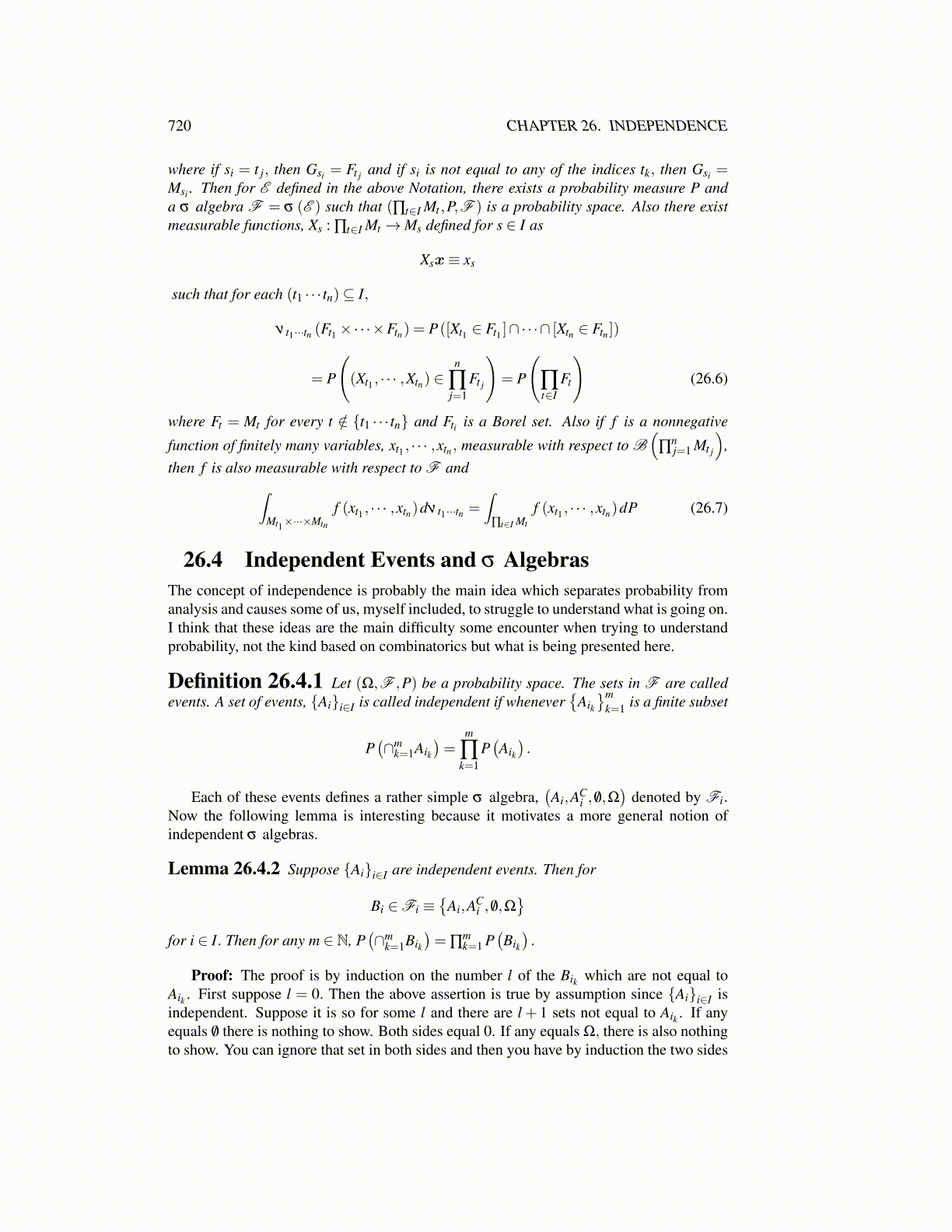
720 CHAPTER 26. INDEPENDENCE
where if si = t j, then Gsi = Ft j and if si is not equal to any of the indices tk, then Gsi =Msi . Then for E defined in the above Notation, there exists a probability measure P anda σ algebra F = σ (E ) such that (∏t∈I Mt ,P,F ) is a probability space. Also there existmeasurable functions, Xs : ∏t∈I Mt →Ms defined for s ∈ I as
Xsx≡ xs
such that for each (t1 · · · tn)⊆ I,
ν t1···tn (Ft1 ×·· ·×Ftn) = P([Xt1 ∈ Ft1 ]∩·· ·∩ [Xtn ∈ Ftn ])
= P
((Xt1 , · · · ,Xtn) ∈
n
∏j=1
Ft j
)= P
(∏t∈I
Ft
)(26.6)
where Ft = Mt for every t /∈ {t1 · · · tn} and Fti is a Borel set. Also if f is a nonnegative
function of finitely many variables, xt1 , · · · ,xtn , measurable with respect to B(
∏nj=1 Mt j
),
then f is also measurable with respect to F and∫Mt1×···×Mtn
f (xt1 , · · · ,xtn)dν t1···tn =∫
∏t∈I Mt
f (xt1 , · · · ,xtn)dP (26.7)
26.4 Independent Events and σ AlgebrasThe concept of independence is probably the main idea which separates probability fromanalysis and causes some of us, myself included, to struggle to understand what is going on.I think that these ideas are the main difficulty some encounter when trying to understandprobability, not the kind based on combinatorics but what is being presented here.
Definition 26.4.1 Let (Ω,F ,P) be a probability space. The sets in F are calledevents. A set of events, {Ai}i∈I is called independent if whenever
{Aik
}mk=1 is a finite subset
P(∩m
k=1Aik
)=
m
∏k=1
P(Aik
).
Each of these events defines a rather simple σ algebra,(Ai,AC
i , /0,Ω)
denoted by Fi.Now the following lemma is interesting because it motivates a more general notion ofindependent σ algebras.
Lemma 26.4.2 Suppose {Ai}i∈I are independent events. Then for
Bi ∈Fi ≡{
Ai,ACi , /0,Ω
}for i ∈ I. Then for any m ∈ N, P
(∩m
k=1Bik
)= ∏
mk=1 P
(Bik
).
Proof: The proof is by induction on the number l of the Bik which are not equal toAik . First suppose l = 0. Then the above assertion is true by assumption since {Ai}i∈I isindependent. Suppose it is so for some l and there are l + 1 sets not equal to Aik . If anyequals /0 there is nothing to show. Both sides equal 0. If any equals Ω, there is also nothingto show. You can ignore that set in both sides and then you have by induction the two sides